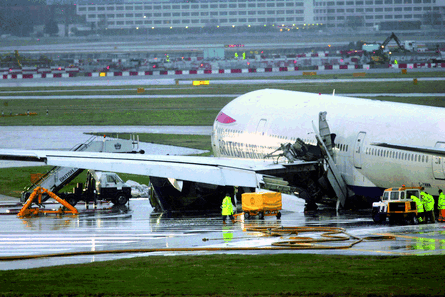Boeing says "similar factors" were likely at play in two Trent 895 thrust rollback incidents on Boeing 777-200ER aircraft last year.
The information was revealed in an update on the incidents the airframer recently sent to operators.
Though Boeing in the update admits the circumstances are "slightly different", the airframer says water-ice accumulation in the fuel path of the engine fuel-oil heat exchanger systems in the powerplants appears to have played role in both situations.
The most recent incident involved a Delta Airlines 777-200ER (N862DA) enroute from Shanghai to Atlanta on 26 November 2008 with 232 passengers and 15 crew. Pilots experienced an uncommanded rollback of the right Rolls-Royce engine while in cruise at 39,000ft approximately 40 minutes after a programmed step-climb. The crew was able to recover the engine after performing flight manual procedures related to the problem and descending to 31,000ft.
 |
|---|
More high profile was the 17 January 2008 crash of a British Airways Trent 895-powered 777-200ER (GYMMM) that crashed short of the runway at London Heathrow after both engines experienced an uncommanded rollback. Though the aircraft was destroyed in the accident, none of the 136 passengers and 16 crew were killed. The UK Air Accidents Investigation Bureau continues to investigate the accident with input from the US National Transportation Safety Board (NTSB), Rolls-Royce and others.
The common failure mechanism in the two incidents would appear to be water ice that accumulated at the front of a series of tubes that carry the fuel to the engine. Part of the fuel-oil heat exchanger, the tubes are located next to fluid lines carrying heated engine oil. From a design standpoint, the mutually beneficial system allows the engine oil to be cooled by the cold fuel while the fuel itself is heated for better combustion performance.
Under certain conditions however, Boeing engineers working in the laboratory have found that the heat generated by the Rolls-Royce designed fuel-oil heat exchanger is not adequate to prevent moisture in the fuel from freezing, a condition that tests have shown will produce ice the blocks the entrance of the fuel to the exchanger, starving the engines.
In the most recent note to operators, Boeing says that 777s powered by GE and Pratt & Whitney engines are not prone to the problem. "Based on our knowledge of the system configurations, scenario studies and laboratory test results, we do not believe that immediate action is necessary or warranted for 777s powered by other engine types or non-777 airframes regardless of engine type," the letter states.
Fuel-oil heat exchangers for GE- and Pratt & Whitney-built engines for the 777 family include a feedback loop that cycles some of the heated fuel back to the front of the device, pre-heating the incoming flow.
Boeing in September proposed interim steps aimed at preventing the problem, actions that were codified by the FAA in an airworthiness directive. Included are "periodic" climbs to higher altitudes using maximum thrust when the main tank fuel temperature is below minus 10°C advancing the throttles to maximum thrust for 10 seconds or until the airspeed reaches M0.86 before descents if fuel temperature is below minus 10°C and the aircraft has been in cruise for three hours, and running fuel pumps for a maximum of one minute during refuelling operations if the fuel in the main tanks is not expected to rise above 0°C before the next flight.
Boeing in the new guidance to operators recommends reducing from three hours to two hours the window at the top of the descent, assuring that cross-feed valves are closed and reducing thrust to idle on both engines for 30 seconds during initial descent, an action officials say will reduce fuel flow to the point that engine oil heat can melt ice that may have accumulated.
For the longer term, industry observers say aviation regulators may call for design changes to the R-R heat exchanger.
R-R declines to comment on the incidents while the investigations are ongoing.
Source: Air Transport Intelligence news























